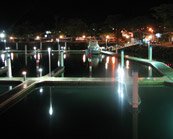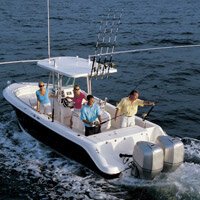The Shape of Things To Come?
The Miami Boat Show, held every February, is a constant for anyone wondering what the future holds for recreational boating. Well, how about this, seen at last winter’s show: a dinghy powered by the sun. The Sea Eagle 10.6 has a solar panel that charges an onboard lithium battery, which powers 1,200 pounds and has a 5’4” beam.
Also attracting attentions at the show was the EzyBoat, a 14 ½-foot boat that folds in half and contains an integrated trailer in the hull so it can be easily towed. Because the wheels retract into the hull once in the water, this unique design can accommodate four passengers and can handle outboards up to 25 horsepower.
If It’s Broke, They’ll Fix It
Non-working pumpout equipment can be the bane of a boater’s existence, but now two states are adding electronic-monitoring devices that will report out-of-order equipment as well as how much sewage is being pumped. Both California and Oregon are requiring that all new pumpout facilities built with state grant funds use the monitors, similar to automated meter-reading equipment used on home utility systems. Non-working equipment is one of the top complaints of recreational boaters, as determined in a 2008 study by the Clean Vessel Act program that provides federal funding to install pumpout equipment at marinas.
“This is just one method that we are trying out to improve equipment maintenance, and a test of six pumpout stations using the monitors in San Diego Bay last year went very well,” reports Kevin Atkinson, who manages the program at the California Dept. of Boating and Waterways. “Monitoring pumpout equipment around a state as big as California requires a tremendous amount of staff time and expense, so using the electronic systems should allow us to monitor more effectively and address any pumpout problems much quicker than in the past.”
The U.S. Fish and Wildlife Service administers the program under the federal Clean Vessel Act, which BoatU.S. helped shepherd through Congress in 1992. It’s funded by boaters and anglers through federal excise taxes they pay on tackle and gasoline used in their boats. Through the Sport Fish Restoration and Boating Trust Fund, the service has awarded more than $172 million since 1992 to install thousands of sewage pumpout stations. Today, many states use pumpout boats to make the sewage collections process more efficient and convenient for boaters. A number of states have begun installing floating restrooms and pumpout stations in high-use areas of lakes and coastal waters with Clean Vessel Act funds. In 2010, the program awarded $12.8 million to 31 states.
Fees Are Up
- Suffolk County, New York - County boat ramps on this section of Long island are going to cost more as a way to cover the cost of maintenance. County officials are hiking the daily fee from $5 to $8 and the annual pass from $25 to $30. Suffolk County operates three boat ramps.
- Lake Lewisville, Texas - The Little Elm Journal reports Little Elm officials are considering a way to (1) contril a crowded boat ramp in Little Elm park, and (2) make the use if the ramp resisdent-based rather than for out-of-residents and $10 for non-residents.
- New Smyrna Beach, Florida - The Merritt Island National Refuge is going to start charging boaters who use the three boat ramps located within the 140,000 acres tract of land. As of July 2011, a daily boat ramp pass will cost $5, while an annual pass can be purchased for $15. Merritt Island is one of 36 wildlife refuges in the United States imposing fees. Nationally, 464 of the 553 wildlife refuges are open to the public.
Ah-Riva-Derci!
One of the last six wooden boats built by the Cantieri Riva Boatyard in Italy has been auctioned off for $975,000. The 1996 Riva Aquarama, hull #774, had just 20 hours on its twin Riva Crusader 454 CI engines. The boat got the highest bid at the Mecum Auction in Kissimmee, Florida, where more that 1,500 new and classic cars were also up for sale.
New Mega-Ramp In California
Lake Elsinore, Southern Caifornia’s largest freshwater lake, is getting a new six-lane boat ramp as part of a $7.6 million renovation. The lake, located east of Huntington Beach near I-15, is a popular boating, camping, and swimming venue. Under he plans, the lake’s 40-year-old single-lane boat ramp will be replaced, and parking will be made for 270 boat trailers.
Let’s Do Six
The BoatU.S. Collegiate Bass Fishing Championship, the largest event in all of collegiate bass fishing, returns to Lake Lewisville, Texas, for the sixth consecutive year in May. More than 150 teams of student anglers from every region of the country will compete at Lake Lewisville on May 23-27 to decide the 2011 national champions. Camera teams from CarecoTV will be on hand to capture all the action and the event. Two hours of coverage will be featured on the BoatU.S. Collegiate Bass Fishing Championship television series, scheduled to air on Versus in the third quarter of 2011.
Invasive Volunteers
Facing a cost of more than $20,000 to have inspections of every boat launched at Minnesota’s Fish Lake, just northwest of Minneapolis, residents have decided to cover the price using volunteers. The Minneapolis Star Tribune reports Maple Grove boaters have been worried about invasive entering the lake from boats and trailers coming from nearby lakes , including Minnetonka, where they were discovered last year. Originally, the state had been looking at raising boat fees to cover the cost of inspections but the idea was rejected in favor of the state DNR training volunteers to do boat ramp inspections.
Three Communities, and Three Outlooks on Trailerable Boats
City leaders in Quincy, Massachusetts, voted 8-1 to remove working from a law that would’ve restricted the numbers of RVs and boats on a property. The original proposal would have required a boat or RV to be parked in front of a home no longer than 72 hours and then be stored no closer than three feet of property lines and five feet from a building. Boaters appeared at the next meeting and voiced opposition to the idea, saying the town has 27 miles of coastline and the rule would require many to pay for storage of their boats. City leaders dropped the idea.
Meanwhile, in Flagler Beach, Florida, south of St. Augustine, the city commission unanimously approved an ordinance forbidding residents to park their RVs and utility trailers in driveways for more than 72 hours during any one-week period. Notice what’s missing? The commissioners refused to include boat trailers because, according to the Daytona Beach News-Journal, boats are part of the city’s culture. RVs and utility trailers can be stored inside a carport, garage, or in a side or backyard. Boats can remain on their trailers in driveways.
Things are not going as smoothly over at “The Landings” section of Ft. Lauderdale, Florida, however, which is known for its high-end homes. Some residents are worried that the boats parked in driveways are “lowering the tone” of the neighborhood, according to a story in the Ft. Lauderdale Sun-Sentinel. The president of the residential association wants the city to make it a clear-cut code violation to park anything in front of a home that doesn’t belong there. City officials are considering the request for an enhanced zoning law.
Boats Win One
City leaders in Quincy, Massachusetts voted 8-1 to remove wording on a law that would have restricted the numbers of RVs and boats on a property. The original proposal would have required a boat or RV to be parked in front of a home no longer than 72 hours and then be stored no closer to three feet of property lines and five feet from a building. Boaters appeared at the next meeting and voiced opposition to the idea, saying the town has 27 miles of coastline and the rule would require many to pay for storage of their boats. The city leaders dropped the idea altogether.
Content Courtesy of BoatU.S.

